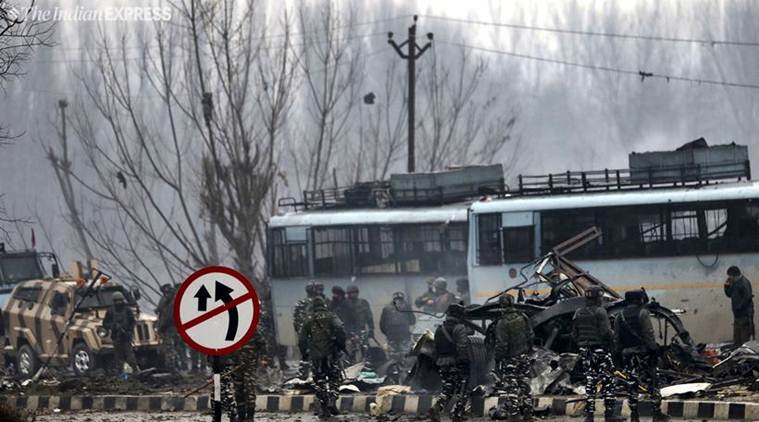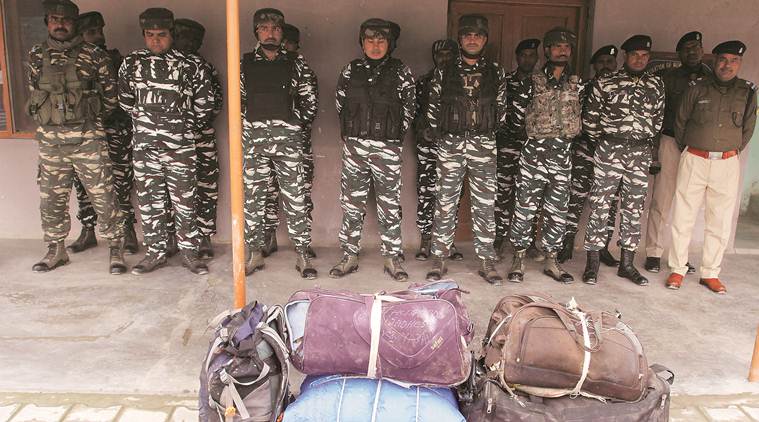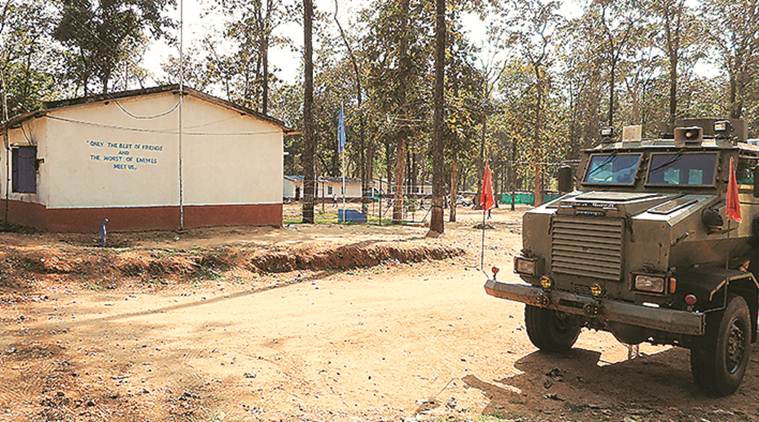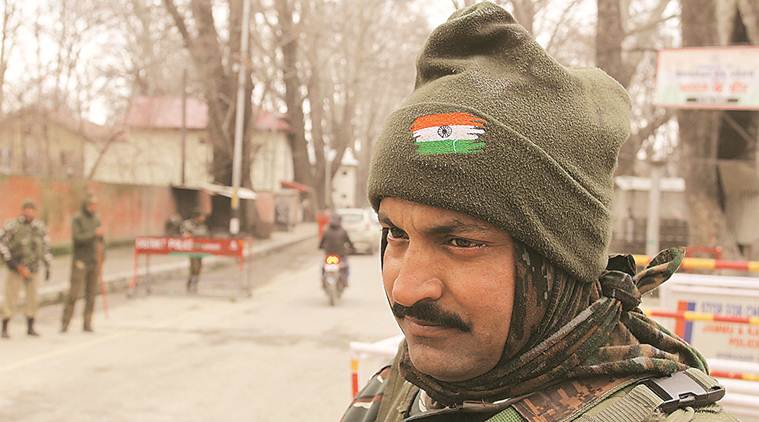
Srinagar: Confined to HQ in a hotel, men say morale high, won’t allow a repeat
In the afternoon of February 14, as the CRPF convoy entered the Valley, Constable Raghvinder Kumar Bharti, 36, from Bihar saw the scenic snowcapped mountains he had heard about for the first time. He was on his first posting to Kashmir, transferred there from Delhi. “My colleagues had told me Kashmir is heaven and, at the same time, the duty is very challenging,” says Kumar.
Within a few hours, his first sight of Kashmir was shattered by the suicide attack hitting a bus in the convoy he was moving in. He realised the extent of the hit much later, says Kumar, who was in 11th of the 34 CRPF buses on the move.

Six days later, as he sits at the headquarters of the CRPF’s 79th Battalion, in a hotel in Sonwar in Srinagar, he says he is yet to venture out into the city. Metres away, all the vehicles entering Srinagar are being frisked by CRPF men.
The CRPF occupies 79 rooms in the hotel and another adjacent to it, housing officials of all ranks. The state government picks up the tab for the accommodation. Officials explain that a 24X7 mess facility ensures men don’t have to venture out for anything. The premises are secured round the clock by armed guards stationed in bunkers, and CCTVs.
The 40,000-strong CRPF troops in Kashmir spend most of their time in camps such as this, unless sought for law and order or other duties.
The convoy that was hit had 31 men from the 79th Battalion. Sitting inside a small room allotted to him, Kumar says the incident has hardened their resolve to perform their duty with more determination. “We have decided that everyone will be 200 per cent alert.”
Havildar Akhleshwar Pandey, 51, who is on his fourth Kashmir posting, was also part of the convoy that was hit. He wife called him in panic, he says, adding that talking to her whenever he gets off duty is part of his routine. Pandey told her something similar to what he says now, “No doubt we are sad, but not a single person is worried about what is going to happen.”
Pandey and two others share a 15×15 ft room. Next to each charpoy is a small trunk for their belongings. The walls are bare as no one is allowed to put up any pictures.
The common recreation room has a television set and a carrom board. However, the CRPF men say, any time off work is mostly devoted to catching up on news or talking to family and friends. Frequent Internet shutdowns in Kashmir mean they often can’t make video calls.
Still, amidst these hardships too, the CRPF personnel say, the Pulwama attack stood out. “I was in Manipur once, there was an ambush, and five of our jawans died. But the Kashmir posting is altogether different,” says Havildar Ravinder Singh, a native of Madhya Pradesh.
Another CRPF man, who doesn’t want to be named, recalls that even within Kashmir, things are not the same. “In the 1990s, whenever we had a cordon, people would assemble at one place and cooperate. Now, the people, instead of supporting us, come in huge numbers and throw stones at us.” Seniors like him are usually around to counsel young CRPF men deputed to Kashmir to tackle scenarios like this.
CRPF IGP, Srinagar sector, Ravideep Singh Sahi says they are prepared to face the “new dimension” posed by the Pulwama attack “upfront”, including during the forthcoming Amarnath Yatra and elections. “The morale of the troops is high. We have finetuned our security drills,” he says.
As funds are collected for the deceased of Pulwama, the faith that things will turn out alright eventually runs deep — deeper than just happiness at the government’s announcement that CRPF men can now travel to Kashmir by air.
“Everyone is confident that seniors will take all steps to ensure nothing of this sort happens again,” says another CRPF man, who is from Uttarakhand.

At Bijapur, Bastar: Among Pulwama dead, their own ‘daredevil’
There is no path in the forest. Every single inch of the undulating land is a mire of thistles, shrubs, trees and, hidden among them, command wires and IEDs. It was March 30, 2018, and like most days, CRPF personnel from the 85th battalion in Bijapur district in Bastar were on an area domination exercise. The blast was sudden. Laxman Rao was the first in the party and, as the IED went off, his legs were injured.
The seconds after an IED blast are fraught with danger, notes B K Jha, the company commander that day. “It can mean there are others around. This can make someone hesitate.” But Constable V V Vasanthakumar did not pause. “He rushed to Rao, wrapped his arms around him, and carried him out. This helped us get him to hospital in time,” Jha recalls.
The act earned Vasantha the CRPF Director General’s commendation disc, the moniker of ‘Daredevil’, and a reputation in the battalion.
Which is why when the name ‘Vasantha’ was mentioned among those had who died in Pulwama, the first reaction was of disbelief. Sudhir Kumar, the Commandant of the 85th battalion, says, “I thought Vasanthakumar had just been transferred to Andhra Pradesh, why would he be in Kashmir so quickly?” But the confirmation came soon after.
The loss of a colleague is not new to CRPF men, but every time, it hurts like one. Vasantha’s colleagues speak of how he was always a “scout” on any exercise, the second or third in a group; of how he was very good at volleyball; and how he was an “all-rounder”, good at both operations and “likhapadhi (writing)” when it came to official documents.
There is little that remains of Vasantha in the Bastar camp now, his bed in his barrack taken over by new personnel. However, when the news of his death came, Kumar says, “We told the boys what had happened, and that they must remember his sacrifice. A prayer meeting was held… I am sending a memento to his family and two young children in Kerala to tell them we remember him.”
A senior CRPF officer stresses the need for such conversations. The six camps that the 85th battalion occupies in Bastar jungles, for example, have no mobile network, and no avenues to take mind off work. “Emotions such as anger, frustration, or even sadness can hamper an operation,” the officer says.
For Vasantha’s former camp, what made his death all the more painful was that he died in an IED hit — an instrument of conflict Bastar is all too familiar with. In March last year, nine CRPF men were killed in an IED hit in Sukma’s Kistaram area, while in November, five CRPF men died in Murtonda in Bijapur when an IED targeted their truck.
In both cases, internal inquiries suggested a lapse in the sacrosanct rule to guard against such attacks: unpredictability. “You have to be on alert constantly, because the Maoists keep reinventing. For instance, they have started wrapping IEDs in carbon or cowdung to distract the sniffer dogs,” a CRPF jawan says.
On February 21, a week after Vasantha’s death in Pulwama, the 85th battalion in Bijapur set off on another area domination exercise, the same as he had been a part of almost a year ago. Few minutes later, they crossed the spot where he had saved Rao’s life — but their eyes didn’t linger there, fixed as they were on the lookout, for an ambush from the hills or a trip wire on the ground.

CRPF Deployment Map
9 LWE-hit states: 90 battalions*, maximum in Chhattisgarh (30 battalions)
J&K: 62 battalions
7 Northeast states: 28 battalions
VIP duty: 4 battalions across India, mostly in Delhi
Rapid Action Force teams: 15 battalions, in Delhi, Aligarh, Meerut, Allahabad, Hyderabad, Coimbatore, Bhopal, Jamshedpur, Jaipur
*1 battalion equals 1,000-odd personnel
Varied duties
Raised in 1939 as ‘Crown Representative Police’, to assist the then British government in dealing with political disturbances, the force was redesignated CRPF in 1947. With nearly 3.25 lakh personnel, it is the largest central armed police force, and is engaged in various duties from internal security and polls to rescue and relief. States prefer it over other central forces due to its skills at crowd management